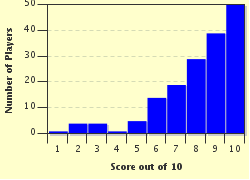Quiz Answer Key and Fun Facts
1. The Battle of Cuito Cuanavale, also known as the Battle of the Lomba River, took place in southern Angola in September and October of 1987. As part of the Angolan Civil War, UNITA (the National Union for the Total Independence of Angola) with help from the South African Defence Force (SADF) fought against forces of the People's Movement for the Liberation of Angola and the South West People's Organization. Forces from which non-African nation fought alongside the MPLA and SWAPO?
2. From March to May in 1954, the Battle of Dien Bien Phu was fought in Indochina. What was the ultimate result of this battle?
3. Planned by the Eisenhower Administration with an invasion force assembled in Guatemala and launched from Nicaragua, what was the name of the battle that took place between April 17 and 19, 1961?
4. For the first three years of the 1950s, savage warfare was conducted in Korea. The USA's fortunes turned in September of 1950 with General Douglas MacArthur's brilliant invasion of what Korean port, which at the time was deep into territory held by North Korea?
5. The USA's involvement in Vietnam was heaviest from 1964 to 1972. In January of 1968 Viet Cong and North Vietnamese Army attacks in over 100 cities of South Vietnam triggered a change in attitude in the United States which eventually led to American withdrawal. By what name were these attacks known, taking place on the Lunar New Year?
6. In May 1975, US President Gerald Ford ordered a Marine attack on a Cambodian island named Kho Tang in an effort to rescue the crew of an American merchant ship that had been captured by Khmer Rouge forces. Can you recall the ship's name?
7. This Central American country suffered through a 12-year civil war from 1979 to 1992. Which country's US-supported military government struggled against the communist-backed Farabundo Marti National Liberation Front (FMLN)?
8. Military victories at Luoyang, Jinan, and, despite heavy casualties, Zhangjakou, ensured a communist government in which nation in 1949?
9. The 1980 Summer Olympics were held in Moscow. However, the USA refused to participate, citing a Soviet invasion of, and military actions in, what Cold War battleground?
10. Europe was not without its Cold War battlegrounds, and two in particular were examples of how the Soviet Union enforced its control over its Eastern European satellites. First in 1956 and then in 1968, to cite the two most famous (or infamous) occasions, Warsaw Pact troops entered sovereign states to put down attempts at self-government. In which two nations did the Soviets suppress these attempts?
Source: Author
shvdotr
This quiz was reviewed by FunTrivia editor
bloomsby before going online.
Any errors found in FunTrivia content are routinely corrected through our feedback system.

